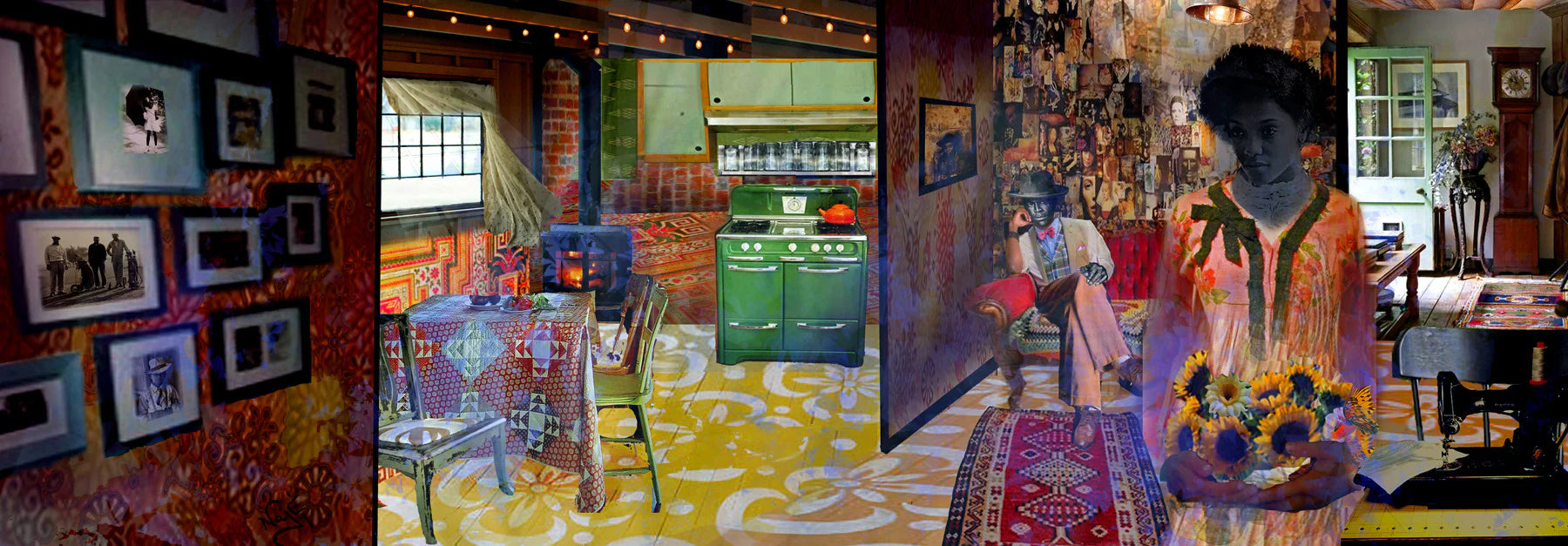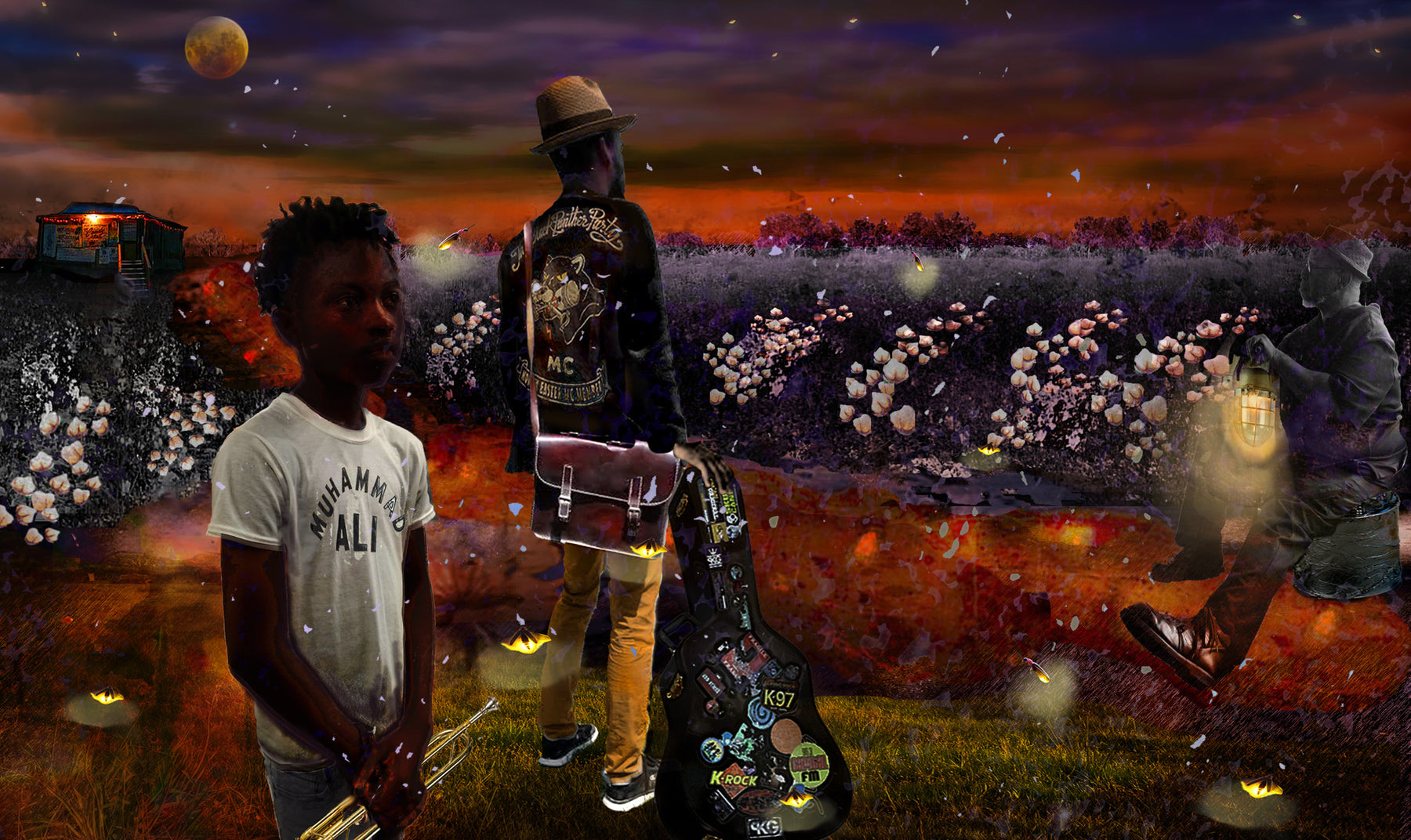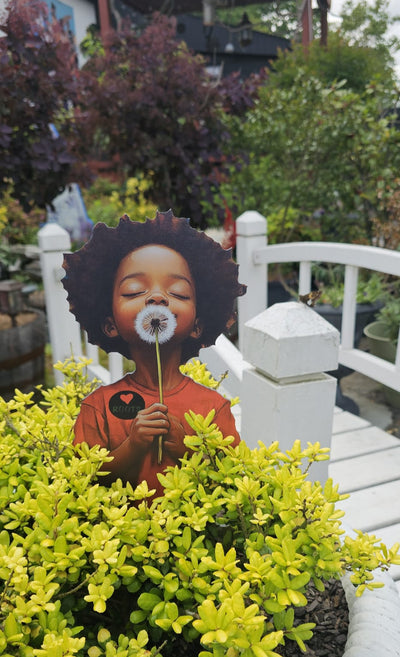Of Spirits, Sinners And The Southern Serendipity Of Najee Dorsey
Of Spirits, Sinners & the Southern Serendipity of Najee Dorsey
by D. Amari Jackson
“There is a time for silence. A time to let go and allow people to hurl themselves into their own destiny. And a time to prepare to pick up the pieces when it's all over.” -Octavia Butler
Timing could not have been more divine. Weeks prior to the May opening of Najee Dorsey’s exhibit, From Beale to Bourbon Street: Deep Down in the Mississippi Delta—and two weeks after Ryan Coogler’s bluesy, southern-themed horror blockbuster Sinners left opening-weekend box office metrics bowed and bloody—an unlikely collector made her way to Black Art in America (BAIA) Gallery and Gardens in East Point to pose a unique offering to the nationally-acclaimed artist.
“What’s interesting is, three weeks ago, we had a lady that came in who was in her 90s—she was 92,” recalled Dorsey, founding CEO of Black Art in America and a proud southern native of Blytheville, Arkansas. Dorsey relayed the account amidst his exhibit—centered by the full-size facade of a juke joint with a six-foot rendering of blues legend Robert Johnson—at a late May panel discussion, Spirits of the South: A Dialogue Around Art, Ancestors, and Tradition. He was joined by spiritualist and psychotherapist, Dr. Ifetayo Ojeladé, and Morehouse professor of African American Studies, Dr. Sam Livingston.
“She said, ‘Listen, I had a good friend that passed away a few years ago and she left me her things, her old family photographs, but I have no connection to them and I didn’t want to just discard them, but something told me to stop here,” recounted Dorsey, pointing to a display of vintage family photos and mementos near the front of the gallery. “I told her ‘You came to the right place, I use them all the time.’ So over half the photographs that’s on that installation come from those family photos,” acknowledged the artist, whose own family images are included as well. “I’ve often said that stories untold are stories forgotten,” stressed Dorsey, a self-proclaimed “hunter-gatherer who likes collecting things. My wife, Seteria, and I love to go thrifting and you know I’m always picking up knickknacks” such as “old license plates, vintage things, or things that were once discarded because they have life in them, they have energy in them.”

Patric Oliver and Dr. Samella Lewis (art family series) by Najee Dorsey
The senior’s unexpected contribution was a timely addition to Dorsey’s exhibit which opened May 22 and runs through July 19 at BAIA. From Beale to Bourbon—which centers the gallery’s third anniversary and Juneteenth festivities in mid-June—celebrates Dorsey’s visual storytelling born at the cultural and spiritual crossroads of the American South and nurtured by this figurative and literal pathway from Beale to Bourbon, one traced by the mighty Mississippi, the same waters flowing by the artist’s Arkansas hometown. Rooted in rhythm and resistance, and employing multiple installments of mixed media, photomontage and sculpture, Dorsey, in alignment with the exhibition statement, “creates a textured narrative where bluesmen and conjure women stand as bastions of remembrance, whispering that ‘stories untold are stories forgotten,” that “beauty lies between memory, myth, and rebirth.”

Woman in interior by Najee Dorsey
Along with the poignant family images, cultural memory is further represented in such exhibit iconography as the potbelly stove, which harkens to “a time when my parents and grandparents grew up” and “times of segregation when our communities were closer and we were forced to deal with each other and live around each other. My mom often talked about how she felt like she was the black sheep of the family,” revealed Dorsey, noting that “even though she wasn’t the oldest and she wasn’t a male, she was the one relegated to having to go get the wood to put in the pot belly stove. And so that’s in part reason why there’s always been this iconography that you find in my work that just kind of takes you to the rural south.”
Even with the serendipitous contribution of his altruistic senior, Dorsey’s impeccable timing—like the rich layers of Alluvial Plain soil covering the Delta region from which he hails—runs deeper.
“Twenty years ago, in the month of May, we moved to Atlanta to pursue being a full-time artist,” he proudly affirmed, before adding that “15 years ago, in the month of May, Black Art in America was founded. May has been a good month for the Dorseys.” Accordingly, the mid-June anniversary of the opening of the BAIA gallery provides a fitting follow up to the magic of May.

"At the End of a Long Dirt Road" by Najee Dorsey
Like Dorsey, it’s a magic born of the South, a mythical land where life is perpetually impregnated by memory, by lore; a hallowed land where cultural remnants retain their resonance; a dangerous land where trees have been known to sprout a strange fruit; a patient land where nothing happens before its time; a sacred land where serendipity surrenders to spirit.
That magic, like the South itself, feeds from deep roots that snake under both land and sea.
“What speaks to me specifically is that our culture here is unique, it’s locally specific but, at the same time, it’s ancient and African,” promoted Livingston, at the event. Upon introducing himself as a “Gullah Geechee man who grew up about two miles from where my ancestors were enslaved,” the South Carolina-born professor stressed that “we are Africans, and that means that we’re not necessarily from just one ethnic group but a cross fertilization of Yoruba, Mende, Akan, Bakongo, and Igbo people. Pan-Africanism is literally in our cultural DNA,” insisted Livingston, noting we further “cross fertilized with the Native American folks we met here. So what stands out to me is it's like, wow, I feel comfortable in my Africanity and I see the beauty of Black people in this local space but also, to me, it’s timeless as well.”

Juke Joint (Installation) by Najee Dorsey
“No music is unsatisfying to me. It’s all got something in it. It’s like that gumbo that’s in that kitchen there. You know how many tastes and meats are in there? I see my music as a gumbo. When you hear me play, there’s everything in there, everything I ever heard and stole from.” -Buddy Guy
For some, Dorsey’s art, for all of its southern iconography, cultural references, and African traditions, conjures up what Ojeladé intentionally labeled as “ancestral memory. I think it’s important for us to specifically name it because it is a straight up African retention,” asserted the psychotherapist, heads nodding back from the audience. Ojeladé depicted how she became a talented chef without any training, how she had “memories of my grandmothers, who were both excellent cooks doing particular things, but I got no instruction,” how she later learned her grandfather was also a chef. “What my daughter calls what I can do is ancestral magic. So when I’m showing up in the kitchen, I’m remembering stuff—I’m not hearing voices, but I am getting specific instruction… try this, do this… I make dishes that were not part of the cuisine that we ate when I was younger, but somebody is telling me that this is what I want you to make.”
“I think it’s important as artists that you recognize that it is ancestral memory that is happening, that you’re pulling up stuff and you’re drawing stuff and you don’t know why, or you’re painting stuff or you’re putting stuff together in a particular way,” continued Ojeladé, adding it is “because that spirit’s talking to us. And I would say, from a psychological perspective, that this is revolutionary, that our ancestors don’t allow us to forget, that we absolutely remember.”
For Dorsey, such memory, tradition and cultural DNA all add up to present a uniquely southern story, one multifaceted yet simple, local and of the land.

Listening Room by Najee Dorsey
“A lot of these stories are rural stories, not even the big cities of Memphis or Jackson, MS or New Orleans,” clarified Dorsey, adding “this is country-folk.” He pointed to an image entitled “Pastures” depicting his maternal grandfather, a mechanic in a small Arkansas community with barely 2000 people. “A lot of the visuals are set to juke joints and rural cities ‘cuz that’s where I feel like that story is best told or where it’s really rooted.” The artist went on to express how the influences of the nearby blues culture of Memphis and the jazz culture of New Orleans mixed with this small town, rural ethos to nurture his artistic perspective.
“The story of Robert Johnson at the crossroads has been a muse of mine for a long time for two reasons,” said Dorsey, of the iconic bluesman who formed the mythological basis for the movie Sinners. Legend has it that, at the crossroads, Johnson sold his soul to become the extraordinary musician that we now remember. First, “I grew up an hour and a half from the crossroads,” he noted, of the fabled intersection of routes 61 and 49 in Clarksdale, Mississippi. Second, while he does not subscribe to the ‘Johnson-deal-with-the-devil’ fable, Dorsey does connect with how Johnson as an artist “chose to say, ‘the heck with everything else that’s going on, I want to play this guitar and this is the only thing I want to do.’ And so I resonate with that because that’s what we do as creatives. We leave the comfort or the supposed security of a 9 to 5 to say this is the most important thing in my life that I want to do and I want to make art.” The main takeaway, for Dorsey, is that “the story of the crossroads is a story that we all share. We all come to various crossroads in our life where we have to make decisions to go one path or another, so it’s really a muse and a metaphor for the life journey.”

Life's a Journey by Najee Dorsey
I went to the crossroad, fell down on my knees
I went to the crossroad, fell down on my knees
Asked the Lord above, ‘Have mercy, now, save poor Bob if you please’-Crossroad by Robert Johnson
“Najee Dorsey’s work shows us that we are essentially worthy and beautiful and transcendent, and our stories are not yet done and our contributions to the world are fundamental,” penned art critic and curator, Kevin Sipp, in “The Crossroads Art of Najee Dorsey” from The Crossroad Blues. His process, wrote Sipp, “gives clues to African and African-American traditions” and “is rooted in multiple medias and layers; aesthetic altars of experience that hold stories and prayers and spiritual powers are part of a deep and long process. This philosophy of the art of the crossroads has existed in our Osirian and Kongo myths, our Ifa and Voudun-informed spiritual practices and art making, in our transatlantic lives, in the montage of our multi-dimensional existence in America, our music making, our quilt-making, in the making of our very bodies and our culture rooted in innovation, collage, montage and sample.”

"3rd Generation Property Owner" by Najee Dorsey
Dorsey’s life journey contains crossroads of its own. At the age of 12, the aspiring artist chopped cotton in the fields of his Arkansas hometown “making $18 a day for an eight-hour shift” while also hustling cinnamon toothpicks to his preteen classmates. By high school, Dorsey’s artistic skills earned him a partial scholarship to the Memphis College of Art (now the Memphis Academy of Art) but the commerce-minded freshman opted out during his first semester to take his chances at making art and money in the ‘real world.’
He’s been doing so ever since. However, along the way, the world did get real as he juggled a wide variety of odd jobs, mostly in sales, while doing art part time. Because of his ongoing struggle to make ends meet, Dorsey admits to going through an earlier period where he “became indifferent about creating” and was more interested in making money than art. But in the early 90s, a timely meeting with prominent artist and community arts activist, Najjar Abdul-Musawwir, would have an indelible impact as Abdul-Musawwir became a friend and mentor. The relationship, which continues to this day, helped rekindle Dorsey’s love for art and steer him back on course as he began producing works that took on issues of civil rights and social justice.
By 2005—after growing in prominence as a full-time artist and having managed an art gallery, coffee-shop, and used book store in his hometown with Seteria—Dorsey was consumed with how to effectively advocate for his fellow African American artists given the myriad of challenges to their careers, many of which he faced. These included “closed doors in the arts community, the lack of representation in art institutions, and the undervaluation of African American art and its creators by dominant society.” Seeking increased visibility and to serve more artists, the Dorseys chose to relocate to the Atlanta area and, five years later, in 2010, launched Black Art In America as an online media platform and resource for African American artists, collectors, art enthusiasts, and arts professionals. Mixing his creative passion with his entrepreneurial drive to provide a valuable national platform for Black art—a 2012 BlackEnterprise.com article on Dorsey and BAIA would tag him as a successful “artrepreneur”—both the company and the dynamic southern artist who founded it have enjoyed wide success ever since.
Still, he recently clarified the chronology. “Black Art in America exists because I’ve been a successful artist,” stressed Dorsey, noting it did not happen the other way around. Over his three-decade career, he has been featured in numerous solo and group museum shows and has received a wide variety of commissions, fellowships, honors, and media coverage for his art. “Seteria and I, as a couple, have reinvested that success into elevating and expanding what we do as a company.”

"Born Liberator" by Najee Dorsey
Dorsey also celebrates this professional and personal success, along with his relentless optimism, in his art. Upon identifying an installment of colorful paintings on the wall as his “Return to Eden series,” he explained how it “came about as a way of celebrating Black love in safe and sacred spaces, essentially imagining a new Eden for us to exist.” In this utopian view, Dorsey details how “the men are kind of fly as they dress dapper” and how this aesthetic is “intentional because this is my protest against how we’re often viewed in media. So I dress the men up intentionally in this form of dandyism, and I’ve been doing that for a while.”
Intentional or by ancestral memory, in the end, it all comes back to Dorsey’s impeccable southern timing.
“When I saw the movie Sinners, I was inspired to say ‘Hey, this is a perfect time to showcase my body of work,” acknowledged Dorsey, who immediately recognized the powerful southern-based elements and connections between Coogler’s work and his own art. So with the fortuitous month of May, the anticipated June anniversary of the gallery, and the success of the film, “I’m like, ‘Man, this is really a perfect time because you get that southern culture, that southern funk, and the history of what I do.”

Black Bottom Blues by Najee Dorsey
From Beale to Bourbon exhibit In the News: Atlanta Voice review
Spirits of the South: A Dialogue on Art, Ancestors, and Tradition A Conversation between Dr. Ifetayo Ojelade, Dr. Sam Livingston and Najee Dorsey, where African tradition, Southern folklore, and contemporary Black Art converge.























